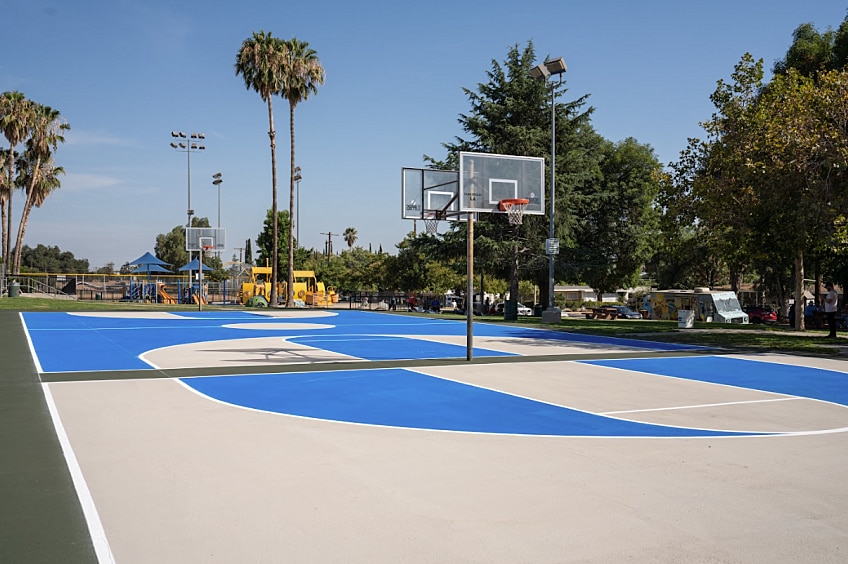Longtime fixtures of playgrounds and recreational areas, sports courts have a lot to offer. In addition to providing opportunities for children and adults to participate in physical activities, they can strengthen communities. There are also other benefits when courts are designed to reduce surface temperatures and protect substrate materials.
Here's a comprehensive look at the benefits of safe, quality sports courts and the impact innovative pavement coatings can have.
Current Challenges with Outdoor Courts
Sports court coatings were developed to help address challenges faced at many levels. By enhancing courts' durability and design, communities are provided with tangible solutions that address many of these challenges.
Increasing Temperatures
Climate change and the heat island effect in urban areas—where hard surfaces like pavement absorb and retain the sun's heat—have led to higher temperatures, potentially affecting the amount of time people can spend outside. Solutions such as building covered structures can be expensive and require a lengthy design and construction process. Planting trees and other landscaping for shade is effective but can take years to develop.
Shrinking Budgets
At the same time, many schools, municipalities, and community organizations have reduced budgets. Play areas are often seen as inconsequential to curriculum, and it can be easy to defer upgrades or repairs.
This has caused facilities to put construction plans on hold and instead search for ways to reduce maintenance costs while extending the useful life of their outdoor equipment and paved surfaces. Staff are tasked with providing options for outdoor activities without investing in expensive equipment or major site renovations.
Growing Health Concerns
In response to these environmental and financial challenges, children have been experiencing less outdoor time and lower physical activity levels. This has been found to play a factor in obesity and mental health. Additionally, regular physical activity for students leads to increased concentration and focus, improved attendance and behavior, and boosts academic performance.
Outdoor play is a great way to get physical activity, form relationships, and work through difficulties. In fact, the American Red Cross recommends using play to help children manage their emotions. Many studies have shown the value of structured and unstructured play for children, reporting it helps build social skills and encourages creativity.
4 Benefits of Pavement Coatings for Outdoor Sports Courts
Sports court surface coatings can address these challenges while providing additional benefits.
1. Space Flexibility
Traditional playground equipment or court markings can limit the outdoor space's use. With a rich palette of colorful coatings and designs, pavement coatings can provide opportunities for a variety of activities.
For example, four square courts can be embedded in traditional basketball court areas, or unique designs can spark imagination, allowing children to create their own games. Providing both children and adults with fewer constraints in how a space is used can help foster creativity and encourage new forms of exercise and play.
Some durable, next-gen pavement coatings may even offer opportunities to create courts that can stand up to vehicular traffic for increased flexibility, providing the ability to turn a court into overflow parking or turning excess parking into a multi-court surface.
2. Lower Costs
Durable pavement coatings can help reduce maintenance costs, by protecting asphalt and cement from damage, which can reduce cracks and extend the usable life of the asphalt or cement substrate. Additionally, coatings may cost less to install than resurfacing or purchasing new equipment.
3. Temperature Benefits
Hardscape surfaces absorb heat, which can increase the air temperature near the surface. By incorporating lighter-colored or solar reflective surface coatings, more heat can be reflected off the surface, reducing the temperature of the surface and potentially, the air temperature near the surface. This can result in cooler outdoor spaces for children and adults to play, which may increase the amount of time they can engage in physical activity.
4. Increased Activity Levels
Studies have shown that creative outdoor play spaces can help increase activity levels and engagement, especially when the surface temperature of the play area has been reduced. An initiative in Boston, which included creating varied outdoor play courts, led to increased physical activity, improved student behavior, and stronger community relationships. In Los Angeles, similar projects led to a 4% gain in the number of students obtaining an hour or more of physical activity per day and a 7.9% decrease in the number of students considered overweight.
How Court Coatings Encourage Play
School may be the only opportunity children have to engage in physical activity, sports, and general play. Reports have repeatedly shown that play patterns can change significantly when colorful coatings are used.
These coatings can help encourage structured activities and games, like four square or hopscotch, or provide the basis for unstructured activities, such as drawing the school logo or a mural. Students can also learn through these surfaces when the pavement is painted with maps or planets. These coatings can have social benefits as well. Playgrounds with a variety of play options may also lead to decreased injuries and an increase in game participation.
How StreetBond® Can Help
When assessing whether to add or transform a hardscape into a sports court, look at three main factors: budgets, safety and health concerns, and the value of play.
StreetBond® pavement coatings can help schools and community organizations transform their hardscapes into robust play areas while meeting their budget constraints. Coatings can help reduce surface temperatures, protect surfaces, and encourage more creative play, helping communities get healthier while learning to work and live together. Visit the StreetBond® website to explore available products, or email streetbond@gaf.com to get support and discuss specific projects.

